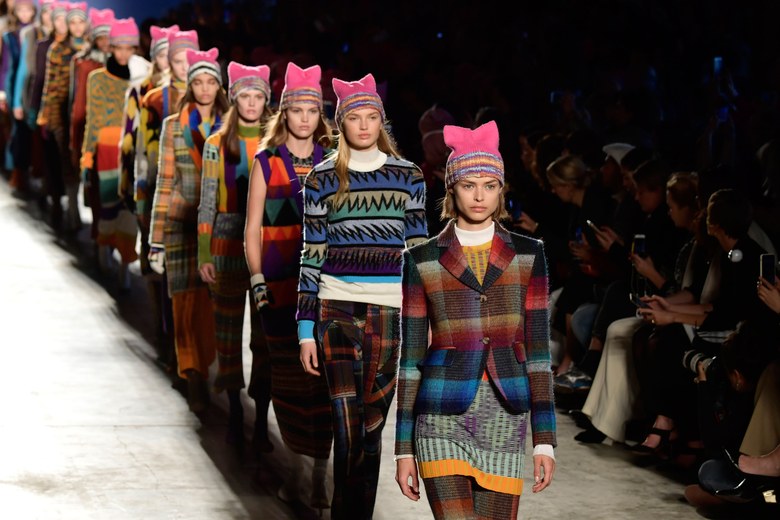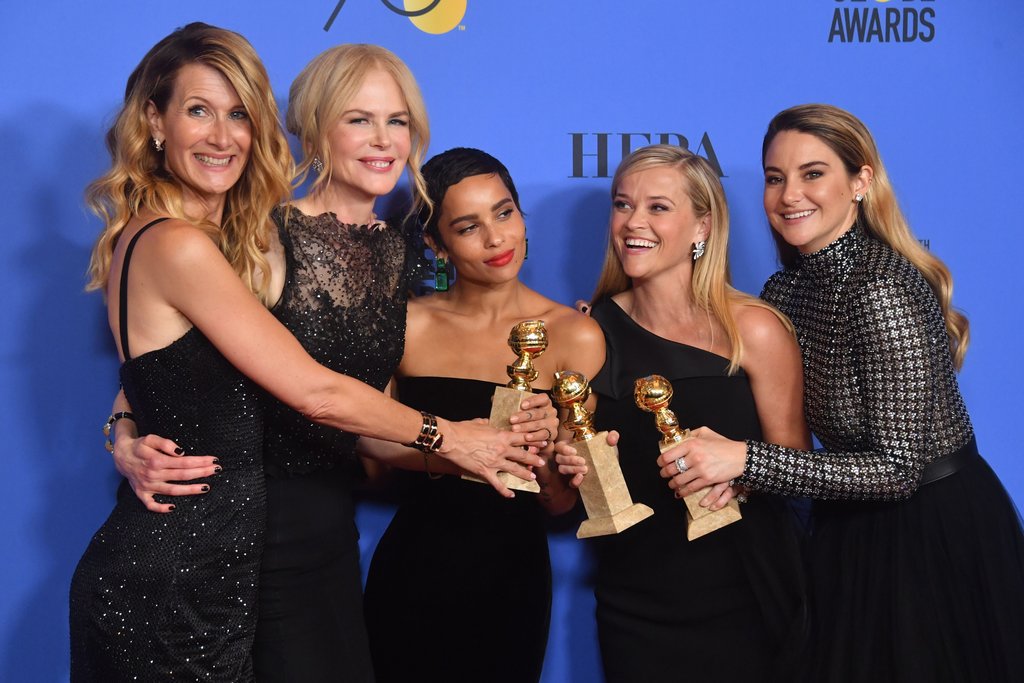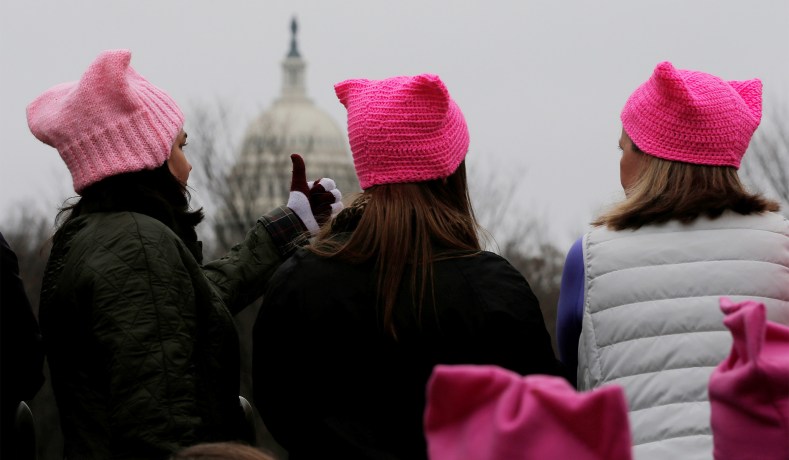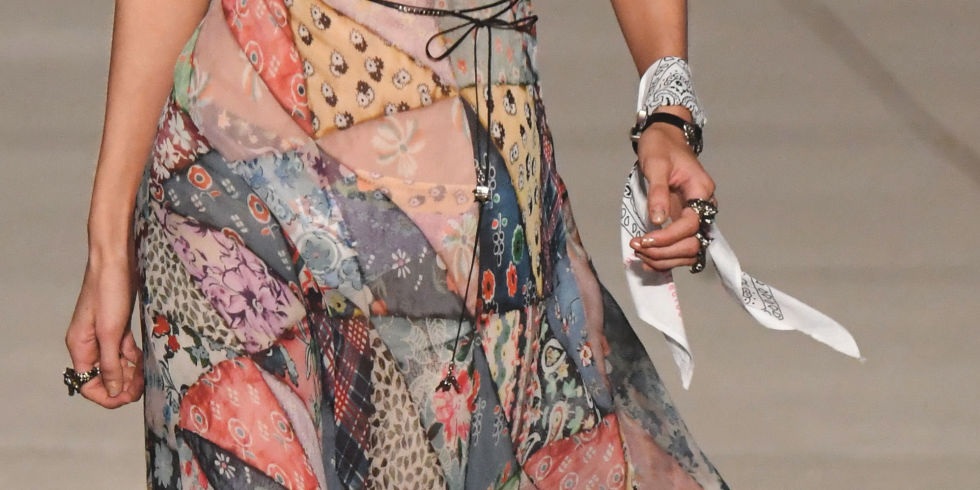This time last year, New York Fashion Week caught the headlines for its decidedly political flavour. Trump’s inauguration was a month past and for many, fashion week was nothing short of trivial in a time of more pressing news. But beyond being merely an escape, the week represented how clothing can comment both prominently and powerfully on political and social issues.
12 months on and rarely has there been a time when so much is being protested. Sexual harassment, racism, gender inequality, workplace injustice, environmental degradation and all things politics are fair game for those who can shout the loudest. But voice has become secondary to the clothes we choose to wear. Slogan tees and hats are the universally-adopted protest starter-pack, and we are more sensitive to the message than ever.
From pink-knitted pussy hats to feminist tees, we’ve spent over a year adorning our lapels with safety pins and statement pins, sewing the zeitgeist into our sartorial choices as a means of resistance. Images are our global currency and we have been quick to ensure that if people are looking, they’re listening too.

The political and social unrest of the last two years came to somewhat of a head this year in the most high-stakes setting: Hollywood. The time of political chatter remaining in the confines of traditionally-political spheres is all but extinct, and society’s most visual industry – the front door to our cultural epoch, if you will – has been sure to get involved in protest dressing. You need to look no further than this year’s Golden Globes for evidence. That story began in October 2017, when the first wave of accusations against Miramax co-founder Harvey Weinstein went public.
As the number of claims against the movie guru grew, the carefully painted silk screen that had previously preserved the horrors of the industry’s gross power imbalance began to peel away. Just a few weeks later, the industry was submerged by accusations of sexual harassment. By December, reports began circulating that women would wear black to the 2018 Golden Globes to protest sexual harassment.

At the annual award ceremony last month, female actors, their male counterparts, agents and studio heads expressed their solidarity with sexual misconduct victims via a red-carpet blackout. The media coverage attracted by the Globes each year was almost entirely focused on the black gowns and what they meant. No doubt the dresses were effective. So effective, even, that the Brits took note, joining the protest in black dresses at the BAFTAs last weekend.
Harnessing the pomp and ceremony of the film industry has given the story a commercial status; it has brought a dialogue into the mainstream media and ensured maximum exposure for the cause. Both at The Globes and the BAFTAs, it felt like the women (and men) taking part were at least attempting to really do something to support equality. As Hollywood stylist Arianne Phillips told Business of Fashion, it wasn’t ‘enough to have a few hashtags.’
But is it enough of a protest to swap one designer frock for a darker-shaded other?
Raising the profile of sexual harassment via the traditionally-superficial mouthpiece of red-carpet fashion and photo opportunities was always going to be a tricky route to navigate. Rose McGowan accused the ‘silent’ protest wearers of ‘hypocrisy,’ and many critics saw the protest as gimmicky, questioning how a couture gown could help to initiate real cultural change. The Sunday Times’ Camilla Long positively skewered the Watson-Streep-Witherspoon clan when she suggested that “the seriousness of this attempt at ‘activism’ can be summed up by the words of [Emma] Stone’s make-up artist, who claimed she had ‘imbued’ her client’s purple eyeshadow ‘with the message of female empowerment and solidarity’ by using colours ‘inspired by the suffragettes.’”
Of course, Long has made an art-form of her mean-spirited jabs, but no doubt she has a point. After all, activist clothing is not activism and the last thing Hollywood needs is more fancy dresses parading as something they’re not.

The film industry’s all-black dress code, as much as it has managed to harness the oxygen of the public, is merely the icing on a 2-year-long protest-dressing cake platter. What began with Dior’s slogan ‘feminist’ tee, quickly turned to resistance hats, in Trump red and ‘pussy’ pink; pins emblazoned with all kinds of messages – ‘Fashion stands with Planned Parenthood’ – silk dresses scripted with famous speeches by revolutionary women; feminist messages splashed across chests – ‘The future is female,’ – slogan t-shirts, white bandanas, safety pins, blue ribbons, white roses on Parab Gurungs New York runway last week, pig masks, $300 jumpers embroidered with ‘poverty is sexist,’ you get the drift.
As someone who is quick to defend fashion against accusations of superficiality, it pains me to suggest that somewhere along the line of $500 slogan tees, we’ve lost sight of the point. ‘Feminism’ has been rendered an empty word splashed across t-shirts, as opposed to a state of equality we should all collectively be fighting for. Male actors dressed in black, donning ‘Times Up’ badges are accused, just days later, of sexual misconduct. Cashmere jumpers embroidered with the slogan ‘poverty is sexist’ could, at their $400 price point, feed an entire impoverished community.

Brands jump on the pop bandwagon, making profit where they can, turning social movements into income streams and exploiting symbols to the point where they become meaningless. Protest has become commodified. But money can’t buy a way to enlightenment, and nor should it. We are all so busy fighting to look sufficiently ‘woke,’ that we’ve forgotten what it is to get our hands dirty. We’ve forgotten the difficult work that comes from advocating for the oppressed. Clothes have provided us with a means to express our political and social beliefs without speaking out, and in doing so, have ruined the art of effective protest. Protest should not be silent.
Nor should it be exclusionary. And here lies my second grievance with resistance wear. The reality is, most people can’t afford to spend hundreds of dollars in the name of splashing slogans across chests, and we don’t all have pink vulvas like those knitted on the Pussyhats. Does that mean we can’t all join the conversation? Shouldn’t protest dressing include the underprivileged and women of colour? If resistance wear is a tool available to only a few, if it’s just another fashion accessory for the white, privileged woman (or man), then it’s already lost its effectiveness. After all, protest is about unifying people, about mobilizing people to the polls, not about wearing one hat, one day of the year.
I’m not denying fashion’s place in protest, merely questioning the weight of such a gesture.

At it’s best, protest dressing is the spokesperson for the real and long-term activism taking place behind-the-scenes. As it was at The Globes. Do I condemn the #TimesUp blackout? Definitely not, because the clothes were merely representative of the activism beneath the glamorous surface. The initiative itself has seen the launch of a legal defence fund, sponsored by Hollywood money to the sum of $13 million and attracting more than 16,000 donations. Camilla Long can laugh until the cows come home at Meryl the ‘painted vampire,’ but the actress donated $500,000 to the fund – money that will provide support to anyone who has experienced sexual harassment, assault or abuse in the workplace. That is doing something. Screw the black dress, it’s what the black dress stands for that matters.
But protest dressing is not just about symbolism. It’s about spreading awareness, providing visual comfort to those in need of it, and lowering the barrier into a sphere that is undoubtedly daunting. A pink pin isn’t just a pink pin, it’s a signal to fearful others that they’re not alone, a ‘hey, I’m with you. I’m ready to stand with you, against the powers that oppress.’ And everybody can wear a pin. Yes, it would be nice to see more people out on the streets, making their voices heard, signing petitions and donating money, but for many, a pin is an entry-point into the world of protest. Not an empty gesture, but a gentle introduction. As London College of Fashion’s Prof Frances Corner points out, “Fashion is a way of engaging in a debate that is accessible to everyone.”
When it comes to awareness, fashion is an empowering mode of expression. In a world where the first line of communication is visual, there is no more effective vessel in portraying a mood, or a message, than what we choose to wear. But it’s one thing to wear a black dress, a pink-knit Pussyhat, or a pin, and to earn praise for doing so. It is quite another to fight behind the scenes – off the red carpet and the catwalk, away from the cameras – for systemic change. Let’s hope the protest dressers can put their money where their mouth is.
How do you feel about using clothing as a political statement or form of protest? Is it effective?






